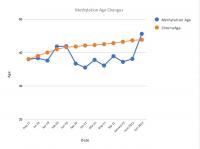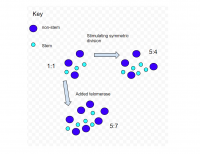Thanks, for the response quest.
Good point, I suppose whether we run into problems downstream on TB's stem cell protocol depends on whether we do enough fusion. I suppose a metric that would seem to matter would be the summed telomere length within the stem pool, and that could be grown. So, for example, we have one stem sell with telomere length X, which could be divided into two stem cells each of length X-d, which in turn subdivide yielding 4 stem cells of length 4(X-2d) and thus net increasing pool length for all d < 3/8 X. So would you think, so long as we're increasing the total telomere length, we're not edging closer to a dramatic cliff edge? Even if the case, there would be limited storage space, one assumes, that we would eventually run into. So, if it were about maximising telomere length of a number of stem cells in a space volume V, then how would we go about doing this optimally? It would seem the best approach would to be to fuse for an extended period before "spending". If going through a process as TB has done which would it seems be to increase stem cell supplies while intermittently emptying them with asymmetric division, the journey is a staggered one, a drunken walk. This is assuming of course, it would take many cycles of fusion to replete the pool, but through that method we end up with a lower average than when finally repleting the stem cell reserves than if we simply embark on a mission of fusion while conserving until repletion.
So in other words, asssuming my mental model is correct, there are three ways in which we could end up with full capacity of stem cells toying with TB's protocol - we could just divide away asymmetically with c60 burning the candle at both ends, diminsh the telomere length and then replete the stem cell pool with telomeres of a low average. Or we could do it on the hoof to rejuvenation, TB's way, fission/fusion, as is the process to retain a higher average or still, just instensely proliferate stem cells until we reason there are no more to add beyond servicing the daily attrition, this would seem to be the best approach. Then embark on spend/replete with the average telmoere length declining but always with a full supply.
I should add the worst case scenario doesn't seem to be realised, as it appears long term c60 users haven't suffered adversely, as best we can know. So, one assumes there is some response to c60 stem cell activation, assuming the theory is correct, preventing rampant depletion.
When mentioning, telomerase charges mitophagy, then I assume you mean the cellular function increases - but what does this mean for our individual telomerase extended mitochondria? On the one hand the mitochondria's chance of being taken to the trash would seem to grow because mitophagy expression ramps up, but on the other, the telomere lengthening would seem to give a defective mitochondria a chance of salvation, escaping the recycling selection criteria. Also, why does telomerase increases mitophagy?
On sensecent cells. I am still not seeing something of the process. Many senescent cells are it seems induced direct into senescence from other sensecent cells and senescence is triggered by telomere length and from that paper, it would seem the shortest telomere length. Apoptosis, too is characterised by short telmoere length, so why one and not the other and it seems pretty clear that senescence is a final destination, not a calling station on the way to apoptosis, not without some considerable help. Also what about extending telomeres on senescent cells, do we know what happens, would this make life tougher for senolytics? Do they behave better with telmoeres lengthened?
I wonder how would be best to incoorporate telomere lenthening into TBs protocols if we had to do it. It would seem that a campaign of inducing apoptosis in near death cells as well the removal of senolytic cells would be good, then telomere lengthening, then extended fusion, followed by the stem cell protocol.
Anyhow, I shall look into telomeres a little more, and at to your thread.
And the questions are not all directed towards you answer, I will have a look sometime myself.






















































